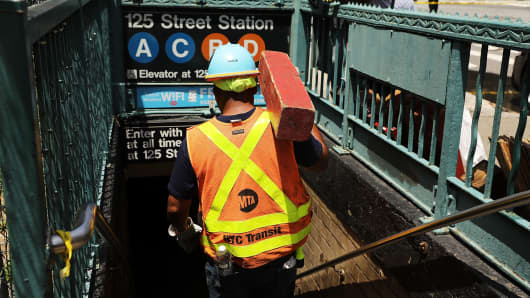In New York, commuters are still reeling from last year's so-called "Summer of Hell." Fires, faulty equipment, and huge crowds paralyzed the subway system upon which the city's financial success is dependent. People were jammed together like sardines. In July, Governor Cuomo declared a state of emergency at the Metropolitan Transit Authority. And Sex and the City star Cynthia Nixon recently stated that she's running against Gov. Cuomo in large part to fix the subway system.
Washington, D.C.'s Metro is in disarray, too. The system constantly makes headlines for derailments, fires, long delays, and emergency closures. In January, a train derailment forced 63 passengers to traverse two football fields' worth of tunnels to escape. The entire Metro system was delayed for hours.
President Trump's plan could make crises like these more common by cutting critical grant initiatives. In Chicago, transit officials might have to scrap plans for a rail extension between the existing subway system and the suburbs. Seattle and Washington, D.C. will have less money for expansion and service.
The administration touts that its proposal would generate $1.5 trillion, but the actual federal contribution would be just $200 billion -- to be split among roads, bridges, and airports, and public transit.
So where does the rest of the funding come from? States and cities, many of which are already strapped for cash. They would have to ante up at least 80 percent of the funding for transit projects to receive -- at maximum -- a 20 percent match from the federal government.
States and municipalities would compete in an urban policy equivalent of The Hunger Games for part of the $200 billion. The feds would prioritize projects that attract the most long-term outside funding, rather than projects that generate the greatest economic and social returns. Toll roads and airport projects earn more profits than mass transit, so they'll get the bulk of the funding.
Public transit may not be very enticing for investors, but these systems deliver solid returns to everyone else. Every dollar that the government plows into public transportation generates $4 in economic activity. And every $1 billion that goes to transit generates 50,000 jobs.
Mass transit investments make cities more productive. For each 10-percent increase in the number of transit seats or rail service miles per capita, urban workers earn up to $1.8 billion extra and cities' economic output grows up to 2 percent. Unsurprisingly then, cities like Seattle and New York -- which deliver a disproportionate amount of national income -- are either highly dependent on mass transit or aiming to become more so.
Other countries understand the benefits of mass transit. So they've constructed transit systems that are more convenient than driving.
Arcadis, a consulting firm, recently ranked global cities on the mobility and sustainability of their transportation systems. No U.S. city cracked the top 20.
Consider the wonders of transit systems in just a few other cities. Singapore's boasts a 99 percent on-time performance rate. Seoul's features cell phone service, wifi, and televisions. Paris has more than 240 metro stations within 30 square miles.
These cities are reaping the economic benefits. And they're better able to attract multinational companies.
To compete internationally, we need to offer states more federal funding for mass transit. Governors know the specific needs of their urban regions and can craft large-scale, long-term plans for their constituents.
President Trump's infrastructure plan will hurt mass transit. That's foolish. Getting these systems back on track is one of the surest ways to maintain the nation's competitiveness.
Commentary by Nicholas Dagen Bloom, associate professor at New York Institute of Technology and the author of "The Metropolitan Airport: JFK International and Modern New York" and the forthcoming book, "State Government and Urban Power" (University of Chicago Press, 2019).
For more insight from CNBC contributors, follow
@CNBCopinion
on Twitter.


